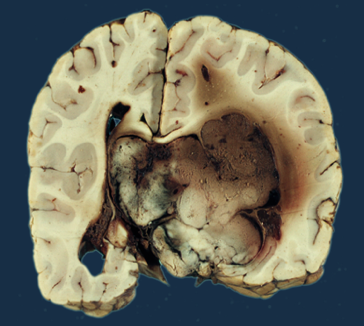Papilloma Of Choroid Plexus

A number sign (#) is used with this entry because of evidence that one form of choroid plexus papilloma (CPP) results from heterozygous mutation in the p53 gene (TP53; 191170) on chromosome 17p13.
DescriptionChoroid plexus tumors are of neuroectodermal origin and range from benign choroid plexus papillomas (CPPs) to malignant choroid carcinomas (CPCs). These rare tumors generally occur in childhood, but have also been reported in adults. Patients typically present with signs and symptoms of increased intracranial pressure including headache, hydrocephalus, papilledema, nausea, vomiting, cranial nerve deficits, gait impairment, and seizures (summary by Safaee et al., 2013).
Clinical FeaturesKomminoth et al. (1965) observed intraventricular papilloma of the choroid plexus in a 2-year-old boy and his 4-year-old sister. Coons et al. (1989) described malignant degeneration of choroid plexus papillomas in 2 sibs.
Rutherford et al. (2002) described a 29-year-old woman with a choroid plexus papilloma who had been successfully treated for an osteosarcoma (259500) at the age of 22 years. There was no family history of cancer.
InheritanceRutherford et al. (2002) described apparent autosomal dominant inheritance of choroid plexus papilloma.
Zwetsloot et al. (1991) observed papillomas of the choroid plexus in a son and daughter of first-cousin parents. Consanguinity and affected sibs suggested autosomal recessive inheritance.
Population GeneticsCPPs have an annual incidence of 0.3 per 1 million and outnumber CPCs by a factor of 5:1. They represent 0.3 to 0.6% of all intracranial tumors, with a male to female ration of 1.2:1 (summary by Safaee et al., 2013).
Molecular GeneticsSevenet et al. (1999) described mutations in the SNF5/INI1 (601607) gene in a number of different forms of childhood tumors, most of which exhibited a rhabdoid phenotype (609322). While mutations were identified in patients with carcinoma of the choroid plexus, including 2 groups of sibs in which one had carcinoma of the choroid plexus and the other(s) had atypical teratoid rhabdoid tumor, the authors found no mutations in patients with papilloma of the choroid plexus. They did, however, identify a mutation in the SNF5/INI1 gene in a case of atypical choroid plexus papilloma.
In a 29-year-old woman with a rare choroid plexus papilloma, who had been successfully treated for osteosarcoma (259500) at age 22 years, Rutherford et al. (2002) detected a germline 7-bp insertion in exon 5 of the p53 gene (191170.0036).
In a male infant who developed an adrenocortical carcinoma (202300) and a choroid plexus carcinoma by age 1.5 years, Russell-Swetek et al. (2008) identified a heterozygous mutation in the TP53 gene (E285V; 191170.0040). Immunohistochemical analysis showed strong positive staining for p53 in the nuclei of both types of cancer cell, consistent with these tumors expressing the mutant p53 protein. Functional analyses of E285V revealed significant defects in its ability to regulate promoter activity, suppress tumor cell growth, and trigger apoptosis. The mutant protein also functioned efficiently as a dominant-negative regulator that neutralized wildtype p53 activity.
Reviews
Safaee et al. (2013) provided a review of choroid plexus papillomas.